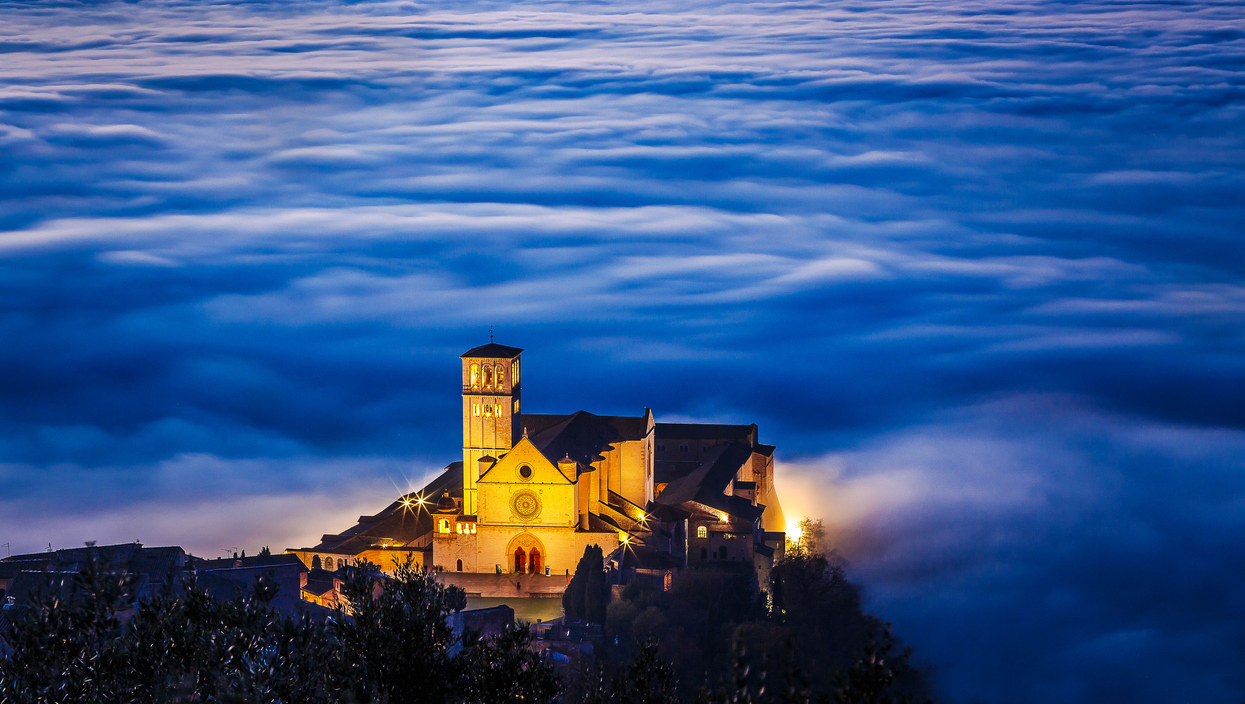In the courtyard of the bishop’s palace, the young man who would become Saint Francis stripped naked in front of his parents and various town and church officials. He handed his clothes with a bag of money on top to his father, saying: ‘I give these back to you. From now on I have one father; the Father in Heaven’.
Deep in the basilica is a striking painting depicting a six-winged Seraphim angel bestowing the stigmata with what looks like lasers
It was a turning point in his life (not to mention devastating for his parents). He would become known as Il Poverello – ’the little poor man’ in Italian’ – famous across the world for embracing a radical simplicity and humility in the pursuit of the divine Godhead, and for turning his back on ‘the economic system of calculated wealth’, as Donald Spoto describes in Reluctant Saint: The Life of Francis of Assisi.
It was also a turning point for the town that Francis called home. The legend of the saint’s life became inextricably intertwined with Assisi’s reputation. It became Italy’s most significant pilgrimage site after Rome. Some argue Assisi is the true spiritual heart of Italy – Saint Francis, after all, composed the first poem in the Italian language.
Assisi is a walled enclave laid out along a spur of Mount Subasio that soars above the town as part of the Apennine Mountain chain running through the region of Umbria (as beautiful as Tuscany next door, just cheaper and with fewer tourists on the whole). A classic hilltop town, it has all the attractive and atmospheric elements you expect to find amid twisting narrow alleys, archways and endless vantage spots from which to gaze at the serene valley below stretching into the distance.
But there is something else that sets Assisi apart, in addition to all the nuns and friars walking around. ‘Certain places have a distinct feeling, presence, or energy of peace,’ says Martin Gray a cultural anthropologist and writer specialising in pilgrimage traditions and sacred sites. ‘Assisi is one of these places.’ Admittedly, this was not immediately obvious when I first arrived in Assisi after traipsing 67 miles across the Franciscan heartland of Umbria while leading a Catholic Herald pilgrimage.
It was bedlam when our group entered the Basilica di San Francesco’s lower chamber, having collected about 20 radios and headsets from the tourism office which tangled around our necks and torsos. Blanketed in pre-Renaissance frescos considered one of the most precious collections in all of Italy, the Irish friar acting as our guide around the church kept warning us to not block the aisles or we would get it in the neck from the ‘security’ personnel keeping an eye on the swarming crowds.
But when coach parties and ‘pilgrims’ who have not come on foot – the shame of it – are no longer rampaging, Assisi feels very different. Wandering the narrow empty streets that wind through the different levels of the town, you get a better sense of the solitude and spiritual calm that was so important to Francis, and which he famously sought out in his caves and reclusive hermitages.
As each day passed at Assisi, I felt myself better able to tune into this calmer frequency, ‘an atmosphere of serene mysticism and deep inner peace’, Derry Brabbs writes in Pilgrimage: The Great Pilgrimage Routes of Britain and Europe. This ‘holy resonance‘ is all the more striking in our age of rush, disturbance, distraction and propaganda from the media-advertising industrial complex.
Like that other great pilgrimage lodestar Santiago de Compostela, there is something about the solid stone walls of Assisi that is reassuring, even meaningful. After all, forged by geologic action over millions of years, those walls contain the ‘energy of the earth’, notes Russ Eanes in Pilgrim Paths to Assisi.
He ponders, as did I there, how that energy might be transferred to those of us surrounded by such ancient building blocks. For there is unquestionably a different (and preferable) sort of energy given off to that from the plate-glass offices and Tower of Babel-like apartment blocks that dominate our modern cities.
Deep in the basilica is a striking painting depicting a six-winged Seraphim angel bestowing the stigmata with what looks like lasers hitting Francis, who is doing an impression of the actor William Dafoe succumbing to the Vietcong at the end of Platoon (the holes in his body even contained the nails too, the friar told us). Various scholars argue that while his hands and feet bore marks, they were the result of illness and his body shutting down after decades of fasting, penance and mortifying the flesh.
Stigmata-ed or not, though, Saint Francis, like all saints, undoubtedly broke through to a dimension of reality and consciousness that most of us will never know or will only ever encounter through the tiniest of glimpses after briefly lifting the corner of the universe to look underneath. We barely glimpse a thing in this life compared to those abstemious mystics.
Assisi, Santiago de Compostela and other sacred sites are transcendent repositories of humanity’s mystical astronauts who, like Saint Francis, ventured beyond the deadened parameters of cold rationality, raw data and empirical evidence that the modern world suffocates people with. They saw.





Comments